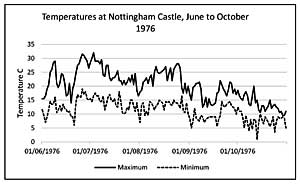Articles from the Thoroton Society Newsletter
1976 - the year with too much summer
Further to my paper in the Summer Newsletter about 1816, when there was no summer worth speaking of, many members will remember 1976, where it could be argued that we had too much summer! This was the year of the Great Drought. The year had started with a fairly dry winter, and came on the heels of relatively low rainfall in 1975, so that reservoirs were already low at the start of 1976. Rainfall remained low throughout the spring of 1976, and then in June the temperatures began to rise. The Met Office reported that at Heathrow there were sixteen consecutive days (23 June to 8 July) with a maximum over 30°C. Over the same period, temperatures reached 32.2°C (90F) or more somewhere in England. On 28 June the temperature at Southampton reached 35.6°C. This is the highest June temperature ever recorded in the UK. The hottest day of all was 3 July, with the temperature at Cheltenham reaching 35.9°C, one of the hottest July days on record in the UK. At the recording station at Nottingham Castle, there were 74 days with temperature of 21 °C or more, 36 days with 25°C or more, and six days when the maximum temperature exceeded 30°C.

One big problem was the drought. The summer and autumn of 1975 were very dry, and the winter of 1975-76 was exceptionally dry, as was the spring of 1976; indeed, in some parts of the country there were some months in this period where no rain fell at all. Hence, water stocks in the nation's reservoirs were already low before the summer of 1976 began. Nottingham was slightly more fortunate than many areas, in that no month in the period had no rain at all, although some (April 1975, 9.7mm and August 1976, 6.4mm) came close. However, Nottingham's water supply does not come from near the Castle! So we experienced the drought as did most other parts of the country. The south-west and southern England were particularly badly hit by the drought, with devastating fires on heath, grassland and forested areas. To add to the problems, there were huge swarms of ladybirds, whose normal food supply (aphids) had dried up, literally. The population of ladybirds had increased suddenly because of the warm spring weather which had allowed an explosion in the aphid population. When the grass and other plants dried up, the aphids died and so the ladybirds swarmed to find alternative food sources. By April 1976, the soils in East Anglia had become so parched that serious soil erosion occurred as the strong easterly winds blew away the topsoil from many fields.
The high temperatures in the summer of 1976 had a serious impact on the health of the population. There were many cases of heat stroke and it was estimated that there was an increase in deaths of some 20% above the normal death rate for the period.
The Government of James Callaghan passed an emergency Drought Act on 6th August 1976. Emergency rules banning the washing of cars and the watering of gardens with hosepipes were introduced. In many areas, water pressure was so low that emergency standpipes were introduced, so that householders had to queue up with cans to collect their water. Unofficial advice was to 'Save water: bath with a friend'. Many ideas as to how to increase water supplies were suggested, included the importing of tankers of water from Norway and 'cloud seeding'. The latter would involve releasing small crystals of various chemicals, one of which was sodium iodide, into clouds to persuade drops of water to form. Few of the ideas were really practical. Eventually, on 24th August, the Government appointed Denis Howells as 'Minister for Drought', with the intention that he should co-ordinate efforts to relieve the situation. A few days later, on Bank Holiday Monday (30th August) the drought was relieved in spectacular fashion with thunderstorms in many parts of the country. At Nottingham Castle on that day, however, there was just 2.6mm. The rains began in earnest in September and continued throughout October, with Nottingham Castle having its heaviest rainfall (27.5mm) on 24th September.

So, although the year 1976 saw one of the worst droughts for very many years, the overall rainfall was not too far below average owing to the very wet September and October. Nottingham Castle's rainfall for the year was 472mm, which is 74% of the long term average.
John Wilson
< Previous